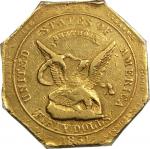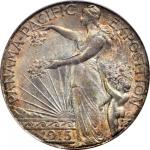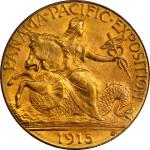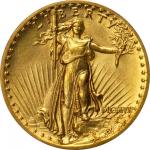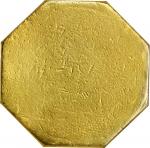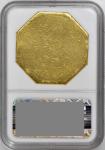This bright khaki-gold example has more vivid yellow gold accents. The central design elements on the obverse are generally well outlined, with the date clear and enough of the ribbon inscription present to discern 900 THOUS with patience. Other devices are weak to indistinct, including much of the engine-turned design on the reverse. Clearly this example saw considerable commercial use and was also cleaned at some point in time. The history of this coin and its link to the California Gold Rush keep its appeal strong among advanced collectors. In January of 1852, John Little Moffat sold his interest in Moffat & Company to his partners, Joseph R. Curtis, Philo H. Perry, and Samuel H. Ward. As part of the dissolution, Curtis, Perry and Ward would retain the Moffat & Company name and continue to strike circulating ingots under government contract. On February 14, the remaining partners dispensed with the Moffat & Co. name and officially formed the United States Assay Office of Gold. Under this rubric the firm would continue to produce the octagonal $50 pieces for which they became famous. The slugs were so highly regarded that T. Butler King, the customs collector at the Port of San Francisco, accepted the pieces despite their not being legal tender, giving them a quasi-official status. Therefore it came as a shock to the local economy when the United States Congress tacked on an amendment to the Civil and Diplomatic Bill on August 31, 1852, that prohibited customs payments from being made in anything less than the .900 federal standard alloy. This proved especially problematic as all Assay Office coins were struck varying purity levels between .880 and .887 fine gold. While the intrinsic value of the pieces exceeded their face value in many cases, Congress felt the substandard purity negatively impacted American coins prestige abroad. This law provoked many protestations in local newspapers and finally city merchants met in October to resolve the situation. As assistant treasurer as well as customs collector, King was obliged to obey the law but indicated he would take .900 fine gold pieces without the mandated copper. The United States Assay Office of Gold then produced an "emergency" issue of $50 coins in .900 fine gold beginning in January 1853 using 1852-dated dies. While King notified Congress of this agreement, they took no action to stop it. The Assay Office continued to produce gold coins and $50 slugs throughout the year. By November 1853, preparation for the opening of the Mint in San Francisco had commenced in earnest and the United States Assay Office finally closed down its coining operations on December 14, 1853. All told, some 23,800 of the $50 slugs were produced, but once federal coins began to be produced in quantity, the vast majority ended their days in the mint s melting pots. Today, at most only a few hundred specimens survive in any grade and those that remain are cherished as mementos of a bygone period. , Est. $7500-$15,000



